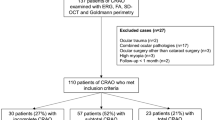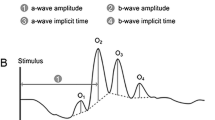Abstract
Purpose
Central retinal vein occlusion (CRVO) is the second most common retinal vascular disorder after diabetic retinopathy that affects the eyes. We propose a method for distinction of normal and central CRVO eyes based on electroretinogram (ERG).
Methods
Seventeen patients with CRVO in one eye were analyzed. Their ERG signals were collected in six different stimuli, including four records in the darkness (dark-adapted 0.01, dark-adapted 3.0, dark-adapted oscillatory potentials, and dark-adapted 10) and two records in brightness (light-adapted 3.0 and light-adapted 30 Hz flicker). Nonlinear features such as Hurst exponent (HE) and approximate entropy (ApEn) were extracted from healthy and CRVO eyes. Finally, a parabolic mapping and two criteria (theta angle and the density of points) were proposed to distinguish the groups.
Results
For ApEn, the P values of dark-adapted 3.0 oscillatory (P = 0.0433) and flicker (P = 0.0425) confirmed significant differences between the groups. For HE, the P values of dark-adapted 3.0 oscillatory (P = 0.0421) and flicker 30 Hz (P = 0.0402) confirmed differences between the healthy and CRVO groups. The P values of theta angle for dark-adapted 3.0 (P = 0.0199), dark-adapted oscillatory (P = 0.0265), dark-adapted 10.0 (P = 0.0166), light-adapted 3.0 (P = 0.0411), and flicker (P = 0.0361) showed significant differences. Using the density criterion, the statistical test demonstrated a significant difference between the groups in dark-adapted 3 (P = 0.0038), dark-adapted oscillatory (P = 0.0102), dark-adapted 10.0 (P = 0.0071), light-adapted 3.0 (P = 0.0319), and flicker 30 Hz (P = 0.0076).
Conclusion
The proposed features have made it possible to distinguish between healthy and CRVO eyes. This method could be helpful in some cases with no definite diagnosis or to estimate the severity of CRVO.





Similar content being viewed by others
Abbreviations
- ApEn:
-
Approximate entropy
- BRVO:
-
Branch retinal vein occlusion
- CRD:
-
Cone-rod dystrophy
- CRVO:
-
Central retinal vein occlusion
- CSNB:
-
Congenital stationary night blindness
- ECG:
-
Electrocardiogram
- EEG:
-
Electroencephalogram
- ERG:
-
Electroretinogram
- ERP:
-
Early receptor potential
- FA:
-
Fourier analysis
- HE:
-
Hurst exponent
- HRVO:
-
Hemiretinal vein occlusion
- ISCEV:
-
Clinical electrophysiology of vision
- LRP:
-
Late receptor potential
- PCA:
-
Principal component analysis
- RP:
-
Retinitis pigmentosa
- RPE:
-
Retinal pigment epithelium
- RVO:
-
Retinal vessel obstruction
- SD:
-
Standard deviation
- WA:
-
Wavelet transform
References
Uhumwangho OM, Itina EI (2015) Retinal diseases in a tertiary hospital in Southern Nigeria. J West Afr Coll Surg 5(2):1–16
Wittström E (2017) Central retinal vein occlusion in younger Swedish adults: case reports and review of the literature. Open Ophthalmol J 11:89–102
Rogers S, McIntosh RL, Cheung N et al (2010) The prevalence of retinal vein occlusion: pooled data from population studies from the United States, Europe, Asia, and Australia. Ophthalmology 117:313–319
Prisco D, Marcucci R (2002) Retinal vein thrombosis: risk factors, pathogenesis, and therapeutic approach. Pathophysiol Haemost Thromb 32(5–6):308–311
Lahey JM, Tunc M, Kearney J et al (2002) Laboratory evaluation of hypercoagulable states in patients with central retinal vein occlusion who are less than 56 years of age. Ophthalmology 109(1):126–131
Hayreh SS, Klugman MR, Podhajsky P, Kolder HE (1989) Electroretinography in central retinal vein occlusion: correlation of electroretinographic changes with pupillary abnormalities. Graefes Arch Clin Exp Ophthalmol 227(6):549–561
Williamson TH, Keating D, Bradnam M (1997) Electroretinography of central retinal vein occlusion under scotopic and photopic conditions: what to measure? Acta Ophthalmol Scand 75(1):48–53
Larsson J, Andreasson S, Bauer B (1998) Cone b-wave implicit time as an early predictor of rubeosis in central retinal vein occlusion. Am J Ophthalmol 125(2):247–249
Larsson J, Bauer B, Andréasson S (2000) The 30-Hz flicker cone ERG for monitoring the early course of central retinal vein occlusion. Acta Ophthalmol Scand 78(2):187–190
Montzka DP, Brucker AJ, Quinn GE (1991) Electroretinogram interpretation in central retinal vein occlusion. Ophthalmology 98(12):1837–1844
Sakaue H, Katsumi O, Hirose T (1989) Electroretinographic findings in fellow eyes of patients with central retinal vein occlusion. Arch Ophthalmol 107(10):1459–1462
Johnson MA, Marcus S, Elman MJ et al (1988) Neovascularization in central retinal vein occlusion: electroretinographic findings. Arch Ophthalmol 106(3):348–352
Hassan-Karimi H, Jafarzadehpur E, Blouri B, Hashemi H, Sadeghi AZ, Mirzajani A (2012) Frequency domain electroretinography in retinitis pigmentosa versus normal eyes. J Ophthalmic Vis Res 7(1):34–38
Gauvin M, Lina J-M, Lachapelle P (2014) Advance in ERG analysis: from peak time and amplitude to frequency, power, and energy. BioMed Res Int, Article ID, p 246096
Nair SS, Joseph KP (2014) Chaotic analysis of the electroretinographic signal for diagnosis. BioMed Res Int, Article ID, p 503920
Bornschein H, Goodman G, Gunkel RD (1957) Temporal aspects of the human electroretinogram: a study of the implicit time-amplitude relationship of the b-wave. AMA Arch Ophthalmol 57(3):386–392
Barraco R, Bellamonte L, Brai M (2007) Time-frequency behavior of the a-wave of the human electroretinogram. IFMBE proceedings 16:919–922
Barraco R, Persano Adorno D, Brai M, Tranchina L (2014) A comparison among different techniques for human ERG signals processing and classification. Phys Med 30:86–95
Miguel JM, Boquete L, Ortega S, Cordero CA, Barea R, Blanco R (2012) MfERG LAB: software for processing multifocal electroretinography signals. Comput Methods Programs Biomed 108(1):377–387
Miguel Jimenez JM, Ortega S, Boquete L, Rodríguez-Ascariz JM, Blanco R (2011) Multifocal ERG wavelet packet decomposition applied to glaucoma diagnosis. BioMed Eng Online 10(37):37
Nair SS, Paul Joseph K (2014) Wavelet-based electroretinographic signal analysis for diagnosis. Biomed Signal Process Control 9:37–44
Crevier DW, Meister M (1998) Synchronous period-doubling in flicker vision of salamander and man. J Neurophysiol 79(4):1869–1878
Molaie M, Falahian R, Gharibzadeh S, Jafari S, Sprott JC (2014) Artificial neural networks: powerful tools for modeling chaotic behavior in the nervous system. Front Comput Neurosci 8(40):40
McCulloch DL, Marmor MF, Brigell MG, Hamilton R, Holder GE, Tzekov R, Bach M (2015) ISCEV Standard for full-field clinical electroretinography. Doc Ophthalmol 130:1–12
Marmor MF, Fulton AB, Holder GE, Miyake Y, Brigell M, Bach M (2009) ISCEV Standard for full-field clinical electroretinography (2008 update). Doc Ophthalmol 118:69–77
Singh A, Kaur J (2016) Approximate entropy (ApEn) based heart rate variability analysis. Indian J Sci Technol 9(47):1–4
Kamath C (2015) Entropy measures of irregularity and complexity for surface electrocardiogram time series in patients with congestive heart failure. J Adv Comput Res 6(4):1–11
Natarajan K, Acharya RU, Alias F, Tiboleng T, Puthusserypady SK (2004) Nonlinear analysis of EEG signals at different mental states. BioMed Eng OnLine 3:7
Blythe DAJ, Haufe S, Müller K-R, Nikulin VV (2014) The effect of linear mixing in the EEG on Hurst exponent estimation. NeuroImage 99:377–387
Adeli H, Dastidar SG, Dadmehr N (2007) A wavelet-chaos methodology for the analysis of EEGs and EEG sub-bands to detect seizure and epilepsy. IEEE Trans Biomed Eng 54(2):205–211
Sullivan G, Feinn R (2012) Using effect size-or why the p value is not enough. J Grad Med Educ 4(3):279–282
Kannathal N, Chee J, Er K, Lim K, Tat OH (2014) Chaotic analysis of epileptic EEG signals. In: Proceeding of the 15th international conference on biomedical engineering, pp 652–654
Behbahani S, Moridani MK (2015) Nonlinear Poincaré analysis of respiratory. Bratisl Med J 116(7):426–432
Moridani MK, Pouladian M (2009) Detection ischemic episodes from electrocardiogram signal using wavelet transform. J Biomed Sci Eng 2(04):239
Behbahani S, Nasrabadi AM (2009) Applications of fuzzy similarity index method in the processing of hypnosis. J Biomed Sci Eng 2(5):359–362
Behbahani S, Nasrabadi AM (2013) The relation of susceptibility levels of hypnosis and different mental tasks. Signal Image Video Process 7(4):1–9
Behbahani S, Dabanloo NJ, Nasrabadi AM, Dourado A (2016) Prediction of epileptic seizures based on heart rate variability. Technol Health Care 24(6):795–810
Behbahani S, Dabanloo NJ, Nasrabadi AM, Dourado A (2016) Classification of ictal and seizure-free HRV signals with focus on lateralization of epilepsy. Technol Health Care 23(1):43–54
Matsui Y, Katsumi O, Sakaue H, Hirose T (1994) Electroretinogram b/a wave ratio improvement in central retinal vein obstruction. Br J Ophthalmol 78:191–198
Breton ME, Schueller AW, Montzka DP (1991) Electroretinogram b-wave implicit time and b/a wave ratio as a function of intensity in central retinal vein occlusion. Ophthalmology 98(12):1845–1853
Yasuda S, Kachi S, Kondo M, Ushida H, Uetani R, Terui T, Piao C-H, Terasaki H (2011) Significant correlation between electroretinogram parameters and ocular vascular endothelial growth factor concentration in central retinal vein occlusion eyes. Investig Ophthalmol Vis Sci 52:5737–5742
Sabates R, Hirose T, McMeel JW (1983) Electroretinography in the prognosis and classification of central retinal vein occlusion. Arch Ophthalmol 101(2):232–235
Ferman-Attar G, Rotenstreich Y (2011) The diagnostic significance of the ERG a/b ratio in retinal disorders. Investig Ophthalmol Vis Sci 52:6073
Acknowledgements
We are grateful to the Ophthalmology Research Center of Shahid Beheshti University for collaborating on classifying and reviewing patients’ clinical information, as well as monitoring database registration. Also, we would like to thank Ms. Hamideh Sabbaghi for coordination with patients and recording the ERG signals.
Funding
Ophthalmology Research Center of Shahid Beheshti University funded this work.
Author information
Authors and Affiliations
Corresponding author
Ethics declarations
Conflict of interest
The authors declare that they have no conflict of interest.
Statement of human rights
All procedures performed in studies involving human participants were by the ethical standards of the (Ethics Committee of Ophthalmic Research Center, Shahid Beheshti Medical University (Tehran, Iran)) and with the 1964 Helsinki declaration and its later amendments or comparable ethical standards.
Statement on welfare of animal
This article does not contain any studies with animals performed by any of the authors.
Informed consent
Informed consent was obtained from all individual participants included in the study.
Additional information
Publisher's Note
Springer Nature remains neutral with regard to jurisdictional claims in published maps and institutional affiliations.
Rights and permissions
About this article
Cite this article
Sefandarmaz, N., Behbahani, S. & Ramezani, A. A novel method for electroretinogram assessment in patients with central retinal vein occlusion. Doc Ophthalmol 140, 257–271 (2020). https://doi.org/10.1007/s10633-019-09742-2
Received:
Accepted:
Published:
Issue Date:
DOI: https://doi.org/10.1007/s10633-019-09742-2




